
In many sports, it’s called being “in the zone.” In baseball, it’s “seeing the ball.” And when you’re “seeing the ball,” you’re putting together multi-hit games, hitting streaks, and home-run tears – everything’s going right for you at the plate.
When you’re “seeing the ball,” it looks bigger, you pick it up sooner, your reactions are quicker and direct. Being able to truly see the ball comes with being able to read the spin.
Reading the spin – and the faster you can do it – allows you to know what kind of pitch is being offered, giving you an extra and valuable advantage. It takes observation, concentration and the mastery of a couple important rules.
Of course, as we’ve already gone over, it’s important to play mind games – to know what to expect from a certain pitcher, his patterns, what he throws, and what he’s thrown to you. Patterns aren’t quite as prevalent as they used to be with all of today’s scouting and coaching. Sure, in Little League or high school, patterns are more predictable, but at every level a lot depends on the pitcher himself. Does he want to get ahead? Can he get his breaking ball over for a strike? Not to mention, at levels such as high school, pitchers aren’t even sure how they want to pitch. So, often times, it’s best to anticipate an opponent’s best pitch in a clutch situation.
But it’s not an easy concept. If you’re guessing the wrong pitch, you cannot adjust. So don’t guess the type of pitch that’s coming your way. It’s all right to look for location, but I always looked for one pitch – the fastball. I prepared myself for it with every pitcher – for no other reason than it was coming at me upwards of 90 miles an hour. So, if you’re not ready for it, you’re going to have a heck of a tough time reacting to it. Every other pitch is slower, whether it’s a slider, curveball, knuckleball, or a change-up.
If you’re ready for the fastball, you can easily delay your mechanics to allow for the slower pitch. But if you’re sitting on a slower pitch and the fastball comes, chances are you’re not going to catch up to it.
So, anticipate the fastball and allow your reactions, your patience, and your discipline to take care of the rest. That’s when the science of reading the spin really gets interesting.
Being able to read the spin isn’t something that you pick up overnight. It takes plenty of work, experience and studying. You will develop that ability over time. But remember, look for the fastball, adjust to the off-speed pitches, and focus on simply seeing the ball.
For more information and additional hitting tips, please visit www.rodcarewbaseball.com or follow on Twitter @rodcarewbball or Facebook at www.facebook.com/rodcarewbaseball.


